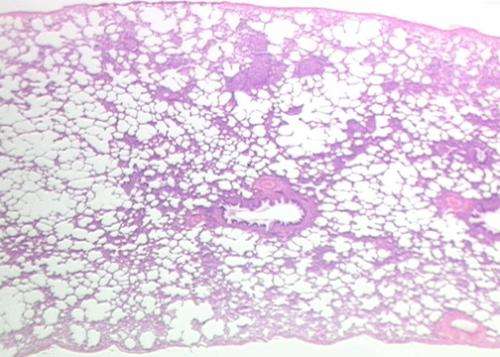New approach uses ultrasound to measure fluid in the lungs

A team of engineering and medical researchers has found a way to use ultrasound to monitor fluid levels in the lung, offering a noninvasive way to track progress in treating pulmonary edema – fluid in the lungs – which often occurs in patients with congestive heart failure. The approach, which has been demonstrated in rats, also holds promise for diagnosing scarring, or fibrosis, in the lung.
"Historically, it has been difficult to use ultrasound to collect quantitative information on the lung, because ultrasound waves don't travel through air– and the lung is full of air," says Marie Muller, an assistant professor of mechanical engineering at North Carolina State University and co-author of a paper on the work. "However, we've been able to use the reflective nature of air pockets in the lung to calculate the amount of fluid in the lung."
When ultrasound waves travel through the body, most of each wave's energy passes through the tissue. But some of that energy is reflected as an echo. By monitoring these echoes, an ultrasound scanner is able to create an image of the tissue that the waves passed through. All of this happens in microseconds.
But when ultrasound waves hit air, all of the energy is reflected – which is why ultrasound images of the lung tend to look like a big, grey blob, with little useful information for health-care providers. And while there are some techniques that allow users to determine if a patient has pulmonary edema, those techniques still can't tell how much fluid there is.
This is where Muller's team comes in.
When ultrasound waves hit air pockets in the lung, or alveoli, they scatter. Those scattered waves hit other air pockets, scattering them further. This process of bouncing around means that it takes an ultrasound's echo much longer to bounce back to the ultrasound machine – though it's still measured in microseconds. And that is why the lung looks like a grey blob to the ultrasound scanner.
But no two ultrasound waves take the same path – they may bounce in different directions as they travel through the lung. So their echoes take different amounts of time to return to the scanner. By looking at all of the echoes, and how those echoes change over time, Muller and her collaborators were able to calculate the extent to which the space between the air pockets was filled with fluid.
To test their approach, the researchers conducted two sets of experiments using rats and rat lung tissue.
In the first set of experiments, researchers used rat lung tissue that had been injected with saline solution to mimic fluid-filled lung tissue. The new approach allowed researchers to quantify the amount of fluid in the lung to within one milliliter.
In the second set of experiments, researchers found significant differences between fluid-filled and healthy lungs in rats. Specifically, the researchers were calculating the mean distance between two "scattering events" – or how far an ultrasound wave traveled between two air pockets.
For fluid-filled lungs, the mean distance was 1,040 micrometers, whereas the mean distance in healthy lungs was only 332 micrometers.
"This is important, because one could potentially track this mean distance value as a way of determining how well pulmonary edema treatment is working," Muller says.
The technique makes use of conventional ultrasound scanning equipment, though the algorithm used by the researchers would need to be incorporated into the ultrasound software.
"Altogether, the cost would likely be comparable to existing ultrasound monitoring applications," Muller says.
The researchers are currently developing two trials: a clinical study in humans and one in a veterinary clinic.
More information: Kaustav Mohanty et al. Characterization of the Lung Parenchyma Using Ultrasound Multiple Scattering, Ultrasound in Medicine & Biology (2017). DOI: 10.1016/j.ultrasmedbio.2017.01.011















